Ths peer reviewed article was first published in the journal Tuith OnlineResearch SummaryA Randomised Controlled Trial to Explore Attitudes to Routine Scale and Polish and Compare Manual Versus Ultrasonic Scaling (ISRCTN99609795)Objectives
28 vocational trainees in Aberdeen, Perth, and Dundee and 420 patients participated. For each dentist, patients were randomised to have a scale either by hand or using ultrasonic instruments. Selected ConclusionsCosts and benefits of routine scale and polish: Patient response to the question "How much did the scale and polish cost?" (to the nearest £) indicates that many patients are unaware of the price paid for individual items of treatment. While 34% of patients correctly answered that a scale and polish cost £8, the remaining 66% of patients gave an incorrect response with 39% answering 'don't know'. 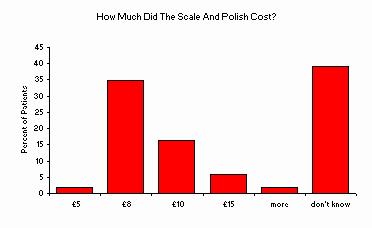
Patients were asked "What do you think is the benefit to you of having a scale and polish?" and, for the same patients, the dentist was asked "What do you think the patient will feel they benefited from having this scale and polish?" The results suggest that very few patients believe a scale and polish is 'of no benefit' to them, 46% believe a scale and polish 'improves appearance' and 78% believe a scale and polish will keep their 'gums healthy'. Within these three response categories the dentist was a good judge of patients' feelings. However, within the remaining two categories dentists' judgements of patients' feelings were less accurate. Although 58% of patients believe that scaling and polishing is instrumental in arresting tooth decay, dentists predicted that only 19% of patients held this belief. Also, a lower number of patients (64%) than expected by the dentists (84%) felt that a scale and polish made their mouths 'feel good'. 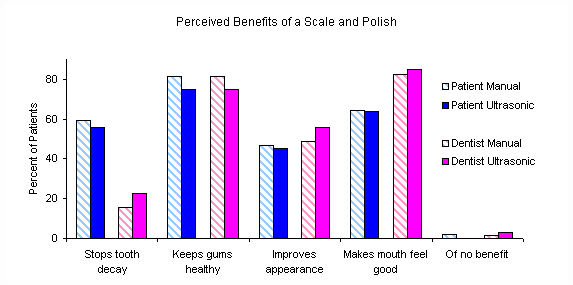
Patients' experience: Patients were asked "What did the scale and polish feel like?" and for each patient the dentist was asked "How do you think the patient felt during the scale and polish?" Comfort levels, for the patients, did not differ markedly between treatments. There was, evidently, marginally more discomfort felt with the ultrasonic treatment with 70% of patients feeling a little uncomfortable or worse compared with 63% undergoing manual scaling. The dentists were inclined to attribute a slightly greater level of discomfort than the patients claimed to feel but identified correctly how many patients were very uncomfortable. 8 patients 'in pain' were not spotted by the dentist.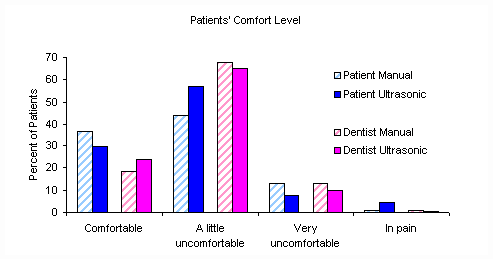
Training experience of trainees: Dentists were asked whether they thought it would be easy to recruit patients for their study. Though most thought that it would be, some had doubts. After the study, there was more of a conviction that it had been easy, with only a minority experiencing difficulties. (Significant p < 0.05 using Wilcoxon Signed Rank Test) 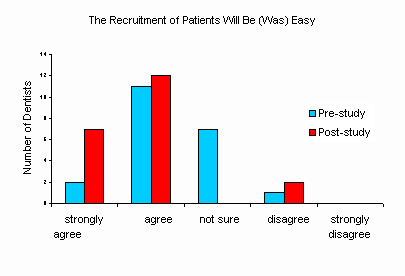
Dentists were asked if administration of the study would significantly disrupt their routine. Prior to the study 43% did not expect disruption and 42% were not sure. Post study, many of the doubters were reassured with 67% responding that the study did not significantly disturb the routine of the clinic. However, a few were discouraged and three dentists indicated that the study had caused more disruption than anticipated. (Not significant) An encouraging result is that the majority of dentists (82%) agree that clinical trials should be carried out in general practice. 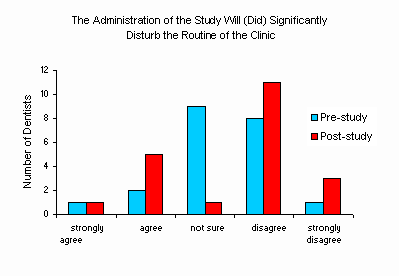
The encouragement and enthusiastic co-operation of Wendy McCombes, Stephen Rafferty, Colin Yule, Derek Harper, and trainers and trainees in the initiation and execution of this study is gratefully acknowledged. Supported by the Scottish Dental Practice Based Research Network (SDPBRN) Dental Health Services Research Unit, Dundee
|
|
Web space provided by the University of Dundee,
maintained by
the Dental Health Services Research Unit. Valid XHTML1.0
|
 |
Evidence-based dentistry web-site | |